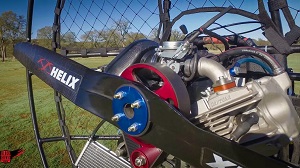How Much Does a Paramotor Cost?
Last Updated on January 6, 2024
Written by CPA Alec Pow | Content Reviewed by ![]() CFA Alexander Popinker
CFA Alexander Popinker
Paramotoring, also known as powered paragliding, is an exciting form of ultralight aviation that has grown rapidly in popularity over recent years. But before you take flight, an important question to consider is how much does a paramotor cost?
In this article, we’ll cover the typical paramotor package prices, training costs, and ongoing expenses so you can determine if this new hobby fits your budget.
How Much Does a Paramotor Cost?
For new pilots looking to buy all the necessary paramotor equipment, package deals that include the paramotor, wing, and other essential gear are the most convenient and cost-effective option.
Complete paramotor package costs typically range from $5,000-$8,000 for high-quality gear ready to fly. Here’s an overview of what’s included:
- Paramotor unit – The engine, propeller, frame, and harness. Popular models like the BlackHawk Talon 190 or Vittorazi Moster 185. ($4000-$6000 for motor)
- Paragliding wing – Special lightweight glider designed for motor thrust. Wings like Ozone Roadster 3 cost around $3,000-$5,000.
- Helmet, reserve parachute, accessories – Head protection, an emergency parachute, radio, flight instruments, etc. Adds around $1,000.
- Training – Initial flight instruction to learn launch, landing, and flying skills. Packages include 25 hours of training. ($2,000 value).
With everything bundled together, new pilots can get airborne while saving money compared to purchasing each piece separately.
Aerial Antics PPG notes that the cost of a paramotor ranges from $5,000 to $10,000, while the wing costs between $2,500 and $4,000.
According to Paramotor Planet, a new paramotor costs around $7,000, with a variation of $1,000 either way depending on the manufacturer. A new beginner paramotor wing costs about $3,600.
An article in FootFlyer says that the cost of a paramotor can vary, but it is generally between $5,000 and $10,000. The wing costs between $2,500 and $4,000.
Additional Costs of Owning Paramotors
Beyond the paramotor package, you’ll need a few additional items:
- USPPA membership – United States Powered Paragliding Association membership for aviation insurance. ($130 per year)
- Transportation – A vehicle like a van, trailer, or truck bed for transporting your gear to flying sites. ($500-$5,000+)
- Fuel – Gas for the paramotor engine. Approximately 2-5 gallons per flight hour. ($40/outing)
- Maintenance costs – Occasional parts replacement and repairs. Budget $1,000/year.
- Weather-appropriate clothing – Flying suit, gloves, boots, etc. to handle outdoor conditions. ($500)
Expect about $1,000-$6,000 in additional costs when first starting paramotoring beyond the paramotor package price. These ongoing expenses are covered next.
What Are the Ongoing Paramotor Costs?
Once you complete training and continue paramotoring regularly, there are recurring costs including:
Fuel – With today’s gas prices plan on $50+ per flight hour. Many paramotor engines use 1-5 gallons per hour depending on size and efficiency.
Maintenance – As parts like propellers wear down, occasional replacement is needed. Budget $1,000 per year.
Engine Reserves – Setting aside savings for future engine rebuilds or replacements every 500-1000 flight hours. Around $4,000 every few years.
Training – Taking continued courses for safety and advancing your skills over the years. $150-$300 per training day.
USPPA membership – Renewing your annual USPPA membership for insurance. ($130 per year).
Travel – Driving or flying to new paramotoring destinations involves transportation costs.
Factor these expenses into your budget to determine if paramotoring fits within your lifestyle and financial means over the long term.
Does Paramotor Training Need to be Renewed?
Initial paramotor flight training focuses on safely learning launch, landing, and basic flying skills. This is included with most pilot package deals.
However, pilots are required to have recurring training to maintain and advance their abilities. The USPPA mandates you complete an annual flight review with an instructor. Staying on top of the knowledge with a few training days per year is vital for all paramotor pilots.
So while the big training investment comes at the start, plan for about $500/year in continuing education. This allows you to fly more challenging conditions and sites, master new techniques, and get instructor feedback. Never stop learning!
What Ongoing Time Commitment is Needed?
Becoming and staying a qualified pilot requires an ongoing time investment beyond the financial costs. Here are some estimates:
- 25+ days for the initial training program
- 3-5 days per year for continuing education
- 2+ flights per month to stay current
- 5-30+ hours per month of flying time
Frequent practice is very important for building experience and muscle memory. Paramotoring requires a substantial commitment, but most pilots find the reward of flying well worth the time invested.
Is Paramotoring an Expensive Hobby Compared to Other Sports?
 While paramotors themselves cost several thousand dollars, powered paragliding can be very cost-effective compared to other forms of aviation. The price per flight hour is far below rental planes or helicopters. Ongoing costs of a powered paraglider are also reasonable if you fly regularly.
While paramotors themselves cost several thousand dollars, powered paragliding can be very cost-effective compared to other forms of aviation. The price per flight hour is far below rental planes or helicopters. Ongoing costs of a powered paraglider are also reasonable if you fly regularly.
You might also like our articles on the cost of a water jetpack, an F18, or a gyrocopter.
However, compared to ground hobbies, paramotoring requires larger upfront and maintenance investments. The gear, licensing, training, and transportation make it a higher budget hobby. But being able to fly under your own powered wings is a one-of-a-kind experience!
Determine what paramotoring is worth to you and budget accordingly. It’s certainly not the most expensive sport, but it does require financial commitment.
Is Owning a Paramotor Worth the Investment?
Only you can decide if buying and operating a paramotor will be money well spent or not. Important factors to keep in mind are:
- Costs compared to your income and savings
- How passionate you are about flying sports
- If you’ll use it enough to justify expenses
- Your commitment to maintaining pilot skills
- If you have access to good weather and flying sites
For adventurers with adequate budgets, paramotoring can be an extremely rewarding and fulfilling sport. But carefully consider the costs before taking the plunge.
Final Words on Paramotor Costs
The initial investment for a complete pilot gear package typically spans $5,000-$8,000. Ongoing costs for fuel, maintenance, training, and USPPA membership add up to roughly $2,000-$3,000 per year.
While not the cheapest sport, paramotoring offers the thrill of powered flight few get to experience. If you have the passion and budget, its an amazing way to spend time flying.


Leave a Reply
Want to join the discussion?Feel free to contribute!